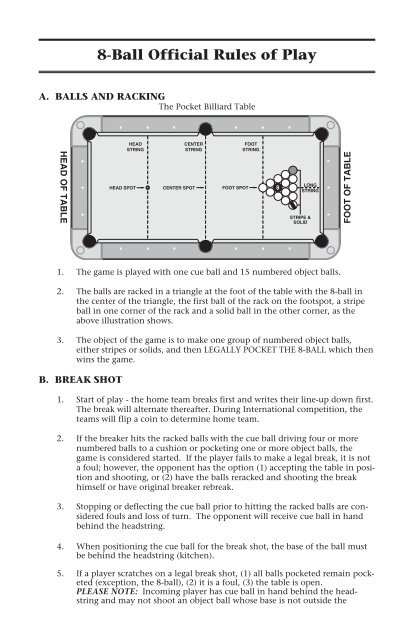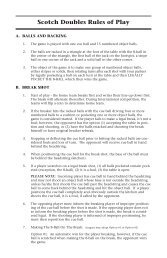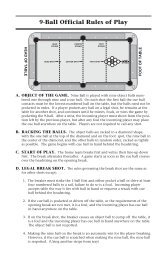8 Ball Rules - VNEA
8 Ball Rules - VNEA
8 Ball Rules - VNEA
Create successful ePaper yourself
Turn your PDF publications into a flip-book with our unique Google optimized e-Paper software.
8-<strong>Ball</strong> Official <strong>Rules</strong> of Play<br />
A. BALLS AND RACKING<br />
The Pocket Billiard Table<br />
HEAD OF TABLE<br />
HEAD<br />
STRING<br />
CENTER<br />
STRING<br />
FOOT<br />
STRING<br />
HEAD SPOT CENTER SPOT FOOT SPOT 8<br />
LONG<br />
STRING<br />
STRIPE &<br />
SOLID<br />
FOOT OF TABLE<br />
1. The game is played with one cue ball and 15 numbered object balls.<br />
2. The balls are racked in a triangle at the foot of the table with the 8-ball in<br />
the center of the triangle, the first ball of the rack on the footspot, a stripe<br />
ball in one corner of the rack and a solid ball in the other corner, as the<br />
above illustration shows.<br />
3. The object of the game is to make one group of numbered object balls,<br />
either stripes or solids, and then LEGALLY POCKET THE 8-BALL which then<br />
wins the game.<br />
B. BREAK SHOT<br />
1. Start of play - the home team breaks first and writes their line-up down first.<br />
The break will alternate thereafter. During International competition, the<br />
teams will flip a coin to determine home team.<br />
2. If the breaker hits the racked balls with the cue ball driving four or more<br />
numbered balls to a cushion or pocketing one or more object balls, the<br />
game is considered started. If the player fails to make a legal break, it is not<br />
a foul; however, the opponent has the option (1) accepting the table in position<br />
and shooting, or (2) have the balls reracked and shooting the break<br />
himself or have original breaker rebreak.<br />
3. Stopping or deflecting the cue ball prior to hitting the racked balls are considered<br />
fouls and loss of turn. The opponent will receive cue ball in hand<br />
behind the headstring.<br />
4. When positioning the cue ball for the break shot, the base of the ball must<br />
be behind the headstring (kitchen).<br />
5. If a player scratches on a legal break shot, (1) all balls pocketed remain pocketed<br />
(exception, the 8-ball), (2) it is a foul, (3) the table is open.<br />
PLEASE NOTE: Incoming player has cue ball in hand behind the headstring<br />
and may not shoot an object ball whose base is not outside the
<strong>VNEA</strong> <strong>Rules</strong> and Scoring<br />
headstring, unless he/she first shoots the cue ball past the headstring and<br />
causes the cue ball to come back behind the headstring and hit the object<br />
ball. If a player positions the cue ball completely and obviously outside the<br />
kitchen and shoots the cue ball, it is a foul, if called by the opponent.<br />
6. The opposing player must inform the breaking player of improper position<br />
ing of the cue ball before the shot is made. If the opposing player does not<br />
so inform the breaking player before the shot is made, the break is considered<br />
legal. If the shooting player is informed of improper positioning,<br />
he/she must then reposition the cue ball.<br />
7. Making The 8-<strong>Ball</strong> On The Break: (Leagues may adopt Option #1 or Option #2)<br />
Option #1. An automatic win for the player breaking, however, if the cue<br />
ball is scratched when making the 8-ball on the break, the opponent wins<br />
the game.<br />
Option #2. The breaker may ask for a rerack or have the 8-ball spotted and<br />
continue shooting. Should the breaker pocket the 8-ball and scratch, the<br />
incoming player has the option of spotting the 8-ball and shooting from<br />
behind the headstring or reracking and assuming the break. Using Option<br />
#2, a game cannot be won or lost with an 8-ball on the break, regardless of<br />
what is pocketed on the same shot.<br />
During International Championships and Junior Championships, Option #2<br />
will be used.<br />
8. If the player legally breaks the racked balls and does not make any balls,<br />
his opponent then shoots, having an open table.<br />
9. If a player jumps an object ball off the table on the break shot, it is a foul<br />
and the incoming player has the option of (1) accepting the table in position<br />
and shooting, or (2) taking cue ball in hand behind the headstring and<br />
shooting. Any jumped balls are spotted in numerical order.<br />
C. OPEN TABLE<br />
The table is “open” when the choice of groups (stripes or solids) has not yet been<br />
determined. When the table is open, it is legal to hit a solid first to make a stripe or<br />
vice versa. Note: The table is always open immediately after the break shot. When<br />
the table is open it is legal to hit any solid or stripe or the 8-ball first in the process of<br />
pocketing the called stripe or solid. On an open table, all pocketed balls remain pocketed.<br />
The choice of stripes or solids is not determined on the break even if balls are<br />
made from only one or both groups. THE TABLE IS ALWAYS OPEN IMMEDIATELY<br />
AFTER THE BREAK SHOT. The choice of group is determined only when a player<br />
legally pockets a called object ball after the break shot.<br />
D. GAME<br />
In Call Pocket, obvious balls and pockets do not have to be indicated. It is the opponent’s<br />
right to ask which ball and pocket if he is unsure of the shot. Banks and combinations<br />
are not considered obvious and both the object ball and the pocket must be<br />
called or it is a loss of turn. When calling the shot, it is NEVER necessary to indicate<br />
details such as the number of cushions, banks, kisses, caroms, etc. Any balls pocketed on a<br />
foul remain pocketed, regardless of whether they belong to the shooter or the opponent.<br />
The opening break is not a “called pocket.” Any player performing a break shot in 8-<br />
<strong>Ball</strong> may continue to shoot his next shot so long as he has legally pocketed any object<br />
ball on the break.
<strong>VNEA</strong> <strong>Rules</strong> and Scoring<br />
When a player has pocketed all of the balls in his group, he then shoots at the 8-ball,<br />
physically designating his pocket with a pocket marker. The marker is to be placed on<br />
the table completely within the first two diamonds on either side of the pocket. The<br />
entire area between the diamonds included. You do not have to touch or move the<br />
marker if it is already at your intended pocket.<br />
E. PLAY<br />
1. If a shooter inadvertently pockets his opponents ball, it remains down,<br />
however, if the shooter does not legally pocket one of his own group, he<br />
loses his turn.<br />
2. Each player continues to shoot so long as he legally pockets any of his<br />
object balls (Exception: calling a safety). Should a player fail to pocket<br />
his designated group ball, he shall lose his turn.<br />
3. If a player fails to hit the 8-ball while shooting at it, it is a foul and the<br />
game continues. When the 8-ball is the legal object ball, a scratch<br />
or foul is not a loss of game if the 8-ball is not pocketed or<br />
jumped off the table. Incoming player has cue ball in hand.<br />
4. In the event the cue ball or an object ball stops on the edge of the pocket<br />
then falls into the pocket because of vibrations, fan or stamping of feet, it<br />
shall be replaced on the edge of the pocket as near as possible to its position<br />
before interference.<br />
5. If any object ball is jumped off the table, it is a foul and loss of turn, unless<br />
it is the 8-ball, which is a loss of game. Any jumped object balls are spotted<br />
in numerical order.<br />
6. SLOW PLAY RULE: Exaggerated slow play will be penalized. After a warn<br />
ing, any longer than ONE MINUTE between shots will be a foul. The third<br />
infraction will result in loss of game. During National competition, referees<br />
judgment will prevail and both players will be timed.<br />
7. STALEMATED GAME: If in 3 consecutive turns at the table by each player<br />
(6 turns total), they purposely foul or scratch and both players agree that<br />
attempting to pocket or move an object ball will result in immediate loss of<br />
game, then the game will be considered a stalemate. The balls will then be<br />
re-racked and the breaker of the stalemated game will break again.<br />
PLEASE NOTE: Three consecutive fouls by one player is not a loss<br />
of game.<br />
F. LOSS OF GAME<br />
1. Pocketing the 8-ball when it is not the legal object ball except on an<br />
opening break.<br />
2. Pocketing the 8-ball on the same stroke as the last of his group of balls.<br />
3. Jumping or knocking the 8-ball off the table at any time.<br />
4. Pocketing the 8-ball in a pocket other than the one designated.<br />
5. Fouling while (pocketing) the 8-ball in the designated pocket.<br />
6. Third infraction of the slow play rule.
<strong>VNEA</strong> <strong>Rules</strong> and Scoring<br />
7. Pocketing the 8-ball and the cue ball on the break stroke. (This varies, if<br />
your league considers an 8-ball break a win.)<br />
8. Not correctly marking the pocket while pocketing the 8-ball.<br />
Note: All infractions above must be called before the next shot is taken.<br />
Only the players involved may call an infraction.<br />
G. LEGAL SHOTS<br />
On all shots (exception: page 11C and on the break), the shooter must hit one of his<br />
group of balls first and (1) pocket any group ball, or (2) cause the cue ball or any other<br />
ball to contact a rail.<br />
* (There are two groups of balls: stripes and solids)<br />
PLEASE NOTE: It is permissible for the shooter to bank the cue ball off a rail before<br />
contacting his object ball; however, after contact with his object ball, any group ball<br />
must be pocketed, OR the cue ball or any other ball must contact a rail.<br />
“SAFETY” SHOT: For tactical reasons a player may choose to pocket an obvious object<br />
ball and also discontinue his turn at the table by declaring “safety” in advance. A<br />
safety shot is defined as a legal shot. If the shooting player intends to play safe by<br />
pocketing an obvious object ball, then prior to the shot, he must declare a “safety” to<br />
his opponent. If this is NOT done, and one of the shooter’s object balls is pocketed,<br />
the shooter will be required to shoot again. Any ball pocketed on a safety shot<br />
remains pocketed.<br />
H. FOULING<br />
All fouls must be called and acknowledged before next shot is taken. (exception: scratching)<br />
The following results in fouls:<br />
1. Failure to make a legal shot as noted above.<br />
2. Shooting the cue ball into a pocket or off table.<br />
3. It is a foul when a player scratches on the break, or deflects the cue ball prior<br />
to hitting the racked balls. The incoming player receives (Cue ball in hand<br />
behind the headstring).<br />
4. When placing the cue ball in position, any forward stroke motion contacting<br />
the cue ball will be a foul, if not a legal shot.<br />
5. Shooting without at least one foot touching the floor.<br />
6. Coaching is a foul. Any member of a team called for coaching will result in<br />
a foul on the team member shooting.<br />
7. Object <strong>Ball</strong> Frozen To Cushion Or Cue <strong>Ball</strong>.<br />
This applies to any shot where the cue ball’s first contact with a ball is with<br />
one that is frozen to a cushion or to the cue ball itself. After the cue ball<br />
makes contact with the frozen ball, the shot must result in either:<br />
a) A ball being pocketed, or;<br />
b) The cue ball contacting a cushion, or;
<strong>VNEA</strong> <strong>Rules</strong> and Scoring<br />
c) The frozen ball being caused to contact a cushion attached to a separate<br />
rail, or;<br />
d) Another object ball being caused to contact a cushion with which it was<br />
not already in contact.<br />
Failure to satisfy one of those four requirements is a foul.<br />
A ball which is touching a cushion at the start of a shot and then is forced into<br />
a cushion attached to the same rail is not considered to have been driven to<br />
that cushion unless it leaves the cushion, contacts another ball, and then<br />
contacts the cushion again. An object ball is not considered frozen to a<br />
cushion unless it is examined and announced as such by either the referee<br />
or one of the players prior to that object ball being involved in a shot.<br />
8. ACCIDENTALLY moving or touching any ball is not a foul unless: 1) the<br />
moved ball is the cue ball or 2) a moved ball makes contact with the cue ball<br />
or 3) a moved ball that is jumped off the table or pocketed or causes any ball<br />
to be jumped off the table or pocketed. (exception to #3: If the 8-ball is<br />
jumped off the table or pocketed it is loss of game if called by the opponent<br />
before the next shot is taken). Only opponent may replace the ball moved<br />
as closely as possible or leave it where it rests. If the shooter replaces the<br />
moved ball, it will be considered a foul.<br />
9. Picking up or shooting the cue ball while any balls are still in motion is a<br />
foul.<br />
10. Push shots and or double hits will be considered fouls.<br />
11. With cue ball in hand, touching any object ball with the cue ball is a foul or<br />
touching any object ball with your hand while touching the cue ball is a<br />
foul.<br />
12. When the slow play rule is enforced taking longer than ONE MINUTE<br />
between shots is a foul.<br />
13. Jumping object balls off the table.<br />
14. After a scratch on a legal break, if a player positions the cue ball completely and<br />
obviously outside the kitchen and shoots it is a foul.<br />
15. If your opponent commits a foul and you do not receive his/her acknowledgement<br />
of such foul prior to touching the cue ball you have committed a<br />
foul. (exception: scratching)<br />
16. Illegal jumping of ball.<br />
I. PENALTY FOR FOULING<br />
1. Only the players involved may call a foul. In the event of a foul call, the<br />
opposing player receives cue ball in hand anywhere on the table. This<br />
means that the player can place the cue ball anywhere on the table (the cue<br />
ball does not have to be behind the headstring except on opening break or<br />
immediately after a foul on the break).<br />
2. A player must stop shooting when a foul is called. If a player refuses to yield<br />
to a foul call, the opposing captain may protest.






